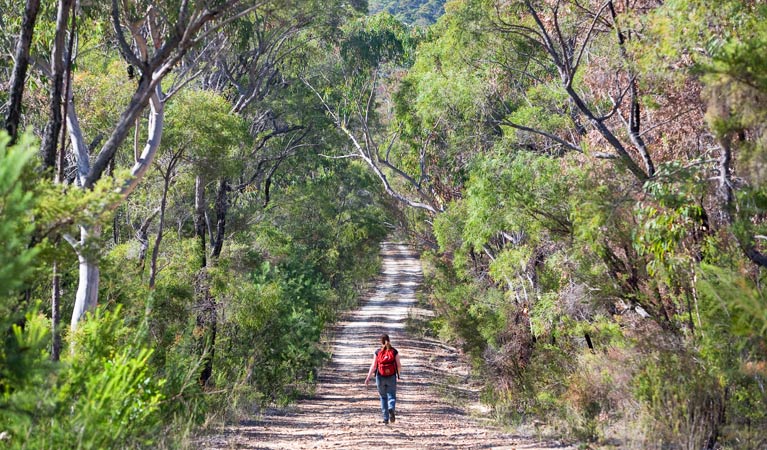Overview
For a challenging bushwalk or mountain bike ride, head to Dubbo Gully loop in Dharug National Park, where you’ll find steep ascents and some amazing history.
- Where
- Dharug National Park in Sydney and surrounds
- Distance
- 18km loop
- Time suggested
- 3-7 hr
- Grade
- Hard
- Opening times
Dubbo Gully loop is always open but may have to close at times due to poor weather or fire danger.
- What to
bring - Drinking water, hat, snacks, sunscreen, sturdy shoes, helmet, bike repair kit
- Please note
- For a shorter mountain bike ride or walk it's 7km return from Mangrove Mountain to the Dharug National Park boundary.
- Allow around 3hrs if mountain biking or 7hrs to hike the full 18km loop.
- If you're planning to camp overnight at Ten Mile Hollow campground you'll need to book your spot before arriving.
- The weather in the area can be extreme and unpredictable, so please ensure you’re well-prepared for your visit.
Definitely not for the fainthearted, this challenging steep track is ideal for adventurous bushwalkers and mountain bike riders who love to test themselves. Dubbo Gully loop combines several trails that lead through rugged and remote bushland, and includes a section of the Old Great North Road built by convicts between 1826 -1836.
Starting at Mangrove Mountain, the first few kilometres wind through Dubbo Gully, passing open fields and an historic old cemetery before reaching Dharug National Park. Continue into the park, along the signposted track to Ten Mile Hollow campground. It's a nice spot for a picnic lunch along the way, or rest your legs, pitch your tent and spend a night under the stars. Bookings required.
Beyond the campground you'll connect with the Old Great North Road. Look for Clares Bridge, the second oldest bridge on the mainland, before looping back to Dubby Gully and returning to Mangrove Mountain.
In Spring, the diverse landscapes come alive with cream flowering Sydney red gums and striking red gymea lilies. You might even see a swamp wallaby hopping across the path.
Map
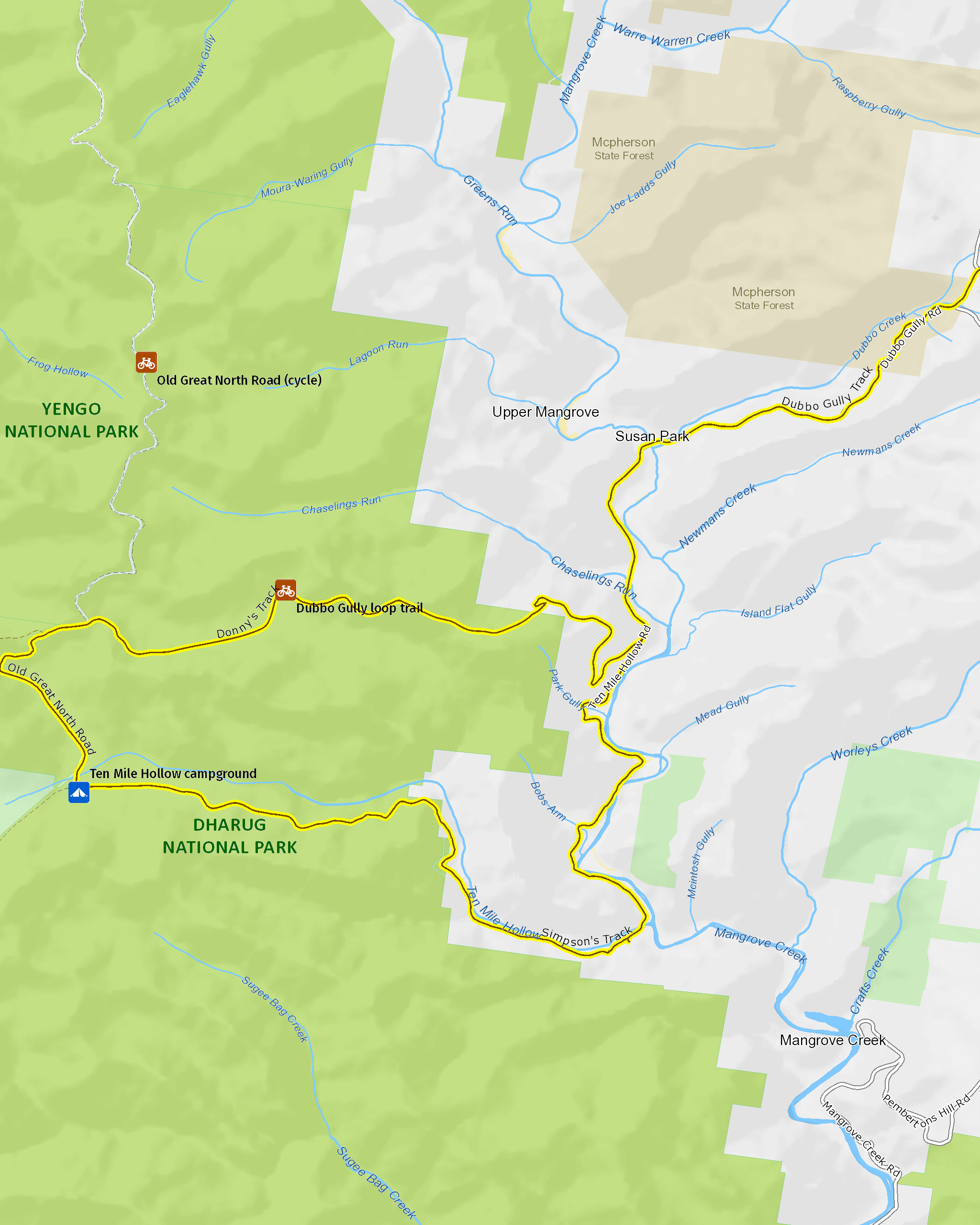
Map legend

Local alerts
For the latest updates on fires, closures and other alerts in this area, see https://www.nationalparks.nsw.gov.au/things-to-do/cycling-trails/dubbo-gully-loop-trail/local-alerts
General enquiries
- National Parks Contact Centre
- 7am to 7pm daily
- 1300 072 757 (13000 PARKS) for the cost of a local call within Australia excluding mobiles
- parks.info@environment.nsw.gov.au
Park info
- in Dharug National Park in the Sydney and surrounds region
Dharug National Park is always open but may have to close at times due to poor weather or fire danger.
Visitor info
All the practical information you need to know about Dubbo Gully loop.
Getting there and parking
Get driving directions
Dubbo Gully loop is in Dharug National Park. To get there:
- Follow Wisemans Ferry Road to Mangrove Mountain
- Turn right into Waratah Road, follow to the end of bitumen (about 4km) and turn left into Dubbo Gully.
Parking
Parking is available along Waratah Road or 500m before the Dubbo Gully gate.
Best times to visit
There are lots of great things waiting for you in Dharug National Park. Here are some of the highlights.
Autumn
The water has warmed up nicely by late summer so autumn is great for kayaking and canoeing along the Hawkesbury river.
Spring
The spring months are perfect for enjoying more strenuous activities in the park, like the longer walks and mountain bike riding. It's also the perfect time to see wildflowers.
Winter
The park is still stunning in winter and walking on sunny days is very pleasant. It can be cold at night so bring warm gear if you're camping.
Weather, temperature and rainfall
Summer temperature
Average
13°C and 27°C
Highest recorded
42.9°C
Winter temperature
Average
8°C and 18°C
Lowest recorded
-0.1°C
Rainfall
Wettest month
February and March
Driest month
September
The area’s highest recorded rainfall in one day
230.2mm
Facilities
- Drinking water is limited or not available in this area, so it’s a good idea to bring your own. The water from the tank at Ten Mile Hollow is not suitable for drinking.
- You’re encouraged to bring gas or fuel stoves, especially in summer during the fire season.
- Composting toilets can be found at Ten Mile Hollow campground
Maps and downloads
Prohibited
Pets
Pets and domestic animals (other than certified assistance animals) are not permitted. Find out which regional parks allow dog walking and see the pets in parks policy for more information.
Smoking
NSW national parks are no smoking areas.
Learn more
Dubbo Gully loop is in Dharug National Park. Here are just some of the reasons why this park is special:
Aboriginal heritage
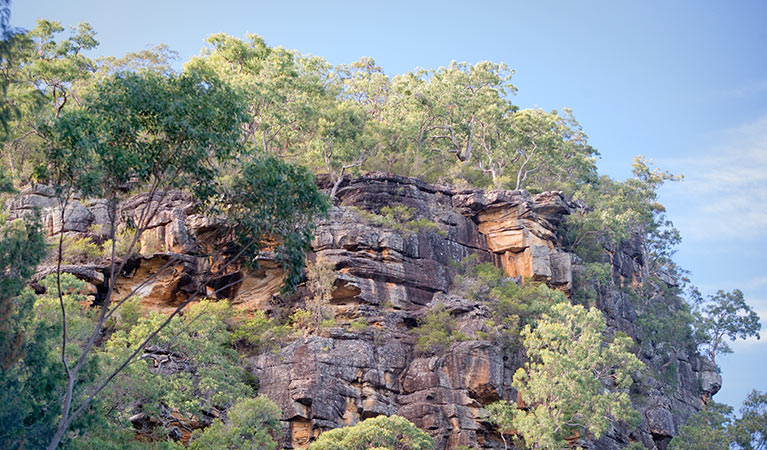
Dharug National Park is the traditional Country of the Dharug Aboriginal people. Abundant in animal, plant and bird life, the area was a rich source of food, medicines and shelter. The park's diverse landscapes and all they contain feature in all aspects of Aboriginal culture and are associated with Dreaming stories and cultural learning that is still passed on today.
Rugged beauty
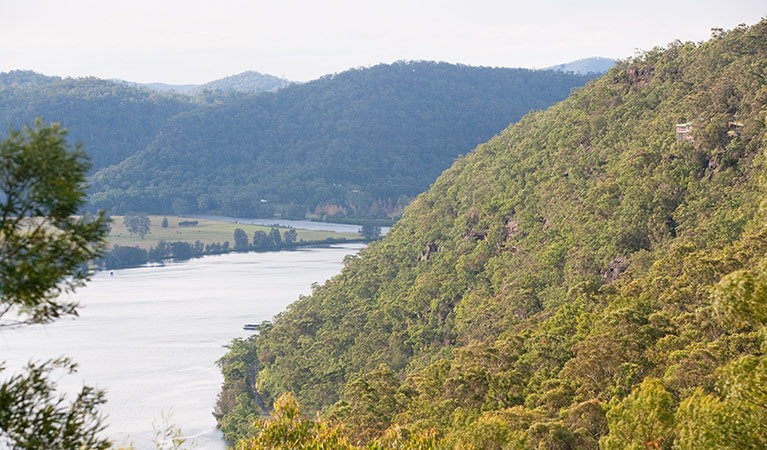
From the rugged bushland containing gang-gang cockatoos, satin bowerbirds and Lewin's honeyeaters to the sparkling waters of the creeks and the rich colours of the sandstone cliffs and formations, Dharug National Park offers a diverse range of landscapes. Bring your bike, bushwalk, camp by the creek, canoe on the Hawkesbury or make the most of the backdrop with your camera, there is so much to explore.
Step into Australia’s past
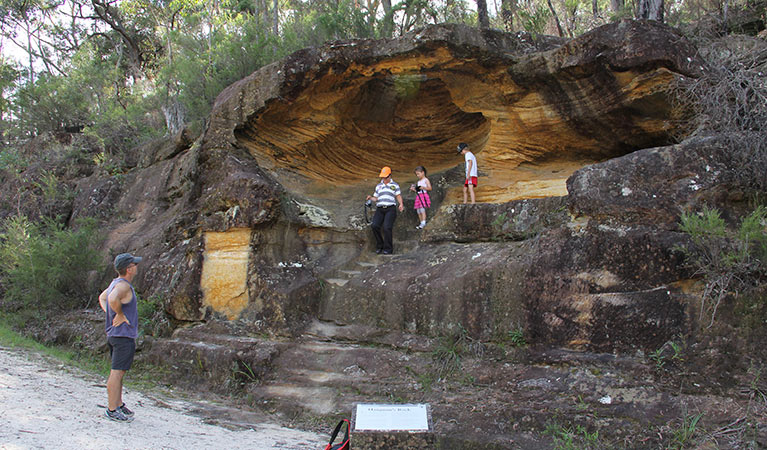
Dharug National Park contains the Old Great North Road, one of 11 historic sites which form the Australian Convict Sites World Heritage property. It's a spectacular example of early colonial engineering and demonstrates the use of convict labour; up to 720 convicts - some in chains - worked on the road, which spanned 264km, connecting Sydney to the settlements of the Hunter Valley. Only 43km of the road remains relatively intact, running from Wisemans Ferry in the south to Mount Manning in the north and includes the oldest surviving stone bridges in mainland Australia. It makes a great walk to explore over two or three days or an exhilarating day's cycle.
- Devines Hill loop Head to Devines Hill loop in Dharug National Park, near Wisemans Ferry this weekend for a bike ride or walk along the historic World Heritage-listed Devines Hill loop.
- Old Great North Road - World Heritage walk Old Great North Road – World Heritage walk highlights a historic convict-built road with scenic river views, via Finchs Line, in Dharug National Park.
Plants and animals protected in this park
Animals
-

Superb lyrebird (Menura novaehollandiae)
With a complex mimicking call and an elaborate courtship dance to match, the superb lyrebird is one of the most spectacular Australian animals. A bird watching must-see, the superb lyrebird can be found in rainforests and wet woodlands across eastern NSW and Victoria.
-

Australian brush turkey (Alectura lathami)
The Australian brush turkey, also known as bush or scrub turkey, can be found in rainforests along eastern NSW. With a striking red head, blue-black plumage and booming call, these distinctive Australian birds are easy to spot while bird watching in several NSW national parks.
-

Bare-nosed wombat (Vombatus ursinus)
A large, squat marsupial, the Australian bare-nosed wombat is a burrowing mammal found in coastal forests and mountain ranges across NSW and Victoria. The only other remaining species of wombat in NSW, the endangered southern hairy-nosed wombat, was considered extinct until relatively recently.
-

Lace monitor (Varanus varius)
One of Australia’s largest lizards, the carnivorous tree-dwelling lace monitor, or tree goanna, can grow to 2m in length and is found in forests and coastal tablelands across eastern Australia. These Australian animals are typically dark blue in colour with whitish spots or blotches.
Plants
-

Gymea lily (Doryanthes excelsa)
The magnificent Gymea lily is one of the most unusual Australian native plants, found only along the coast and surrounding bushland of the Sydney Basin, from Newcastle to Wollongong. In spring this giant lily shoots out spectacular red flowers that can reach heights of 2-4m.

